Scattered among the highly biodiverse forests of South East Asia, millions of farmers eke out their livelihoods by growing cassava. This cash crop – grown by both small-scale farmers who own just one or two hectares and industrial farms spread across thousands of hectares – is sold mainly to manufacturers who use its starch in plastics and glues.
When cassava was first imported to South East Asia from South America (as it was to Africa a few decades earlier), it was able to grow without the help of pesticides. Then in 2008, the cassava mealybug followed the root vegetable to the region and began devastating the crops. To compensate for the losses, farmers began encroaching into the forests around their plots to try to get a little bit more produce from their land.
“Some of those areas are under significant pressure from deforestation,” says Kris Wyckhuys, an expert in biological controls at China Academy of Agricultural Sciences’ Institute of Plant Protection in Beijing. “Cambodia has some of the highest rates of tropical deforestation.”
The arrival of the cassava mealybug not only had major impacts on the livelihoods of those who grow cassava, it affected the national economies of the countries in the region and might have had rippling effects elsewhere.
Substitute products in the starch market like corn and potato rose in price. There was a threefold increase in the price of cassava starch in Thailand – the world's number one exporter of cassava starch.
“When an insect reduces crop yields by 60-80%, you have a major shock,” says Wyckhuys. The solution was to find the mealybug’s natural enemy, a 1mm-long parasitic wasp (Anagyrus lopezi), in its native South America. This wasp is extremely selective about using the cassava mealybug as a host for its larvae. By late 2009 it had been introduced to the cassava cropland in Thailand and had started working its way through the mealybugs.
There's no detailed information on how quickly the wasp drove mealybug populations down in the country. But by mid-2010, “parasitic wasps were being reared by the millions and mass-released throughout Thailand, including by airplane, and we can assume that their impacts on mealybug populations could be felt fairly quickly,” says Wyckhuys.
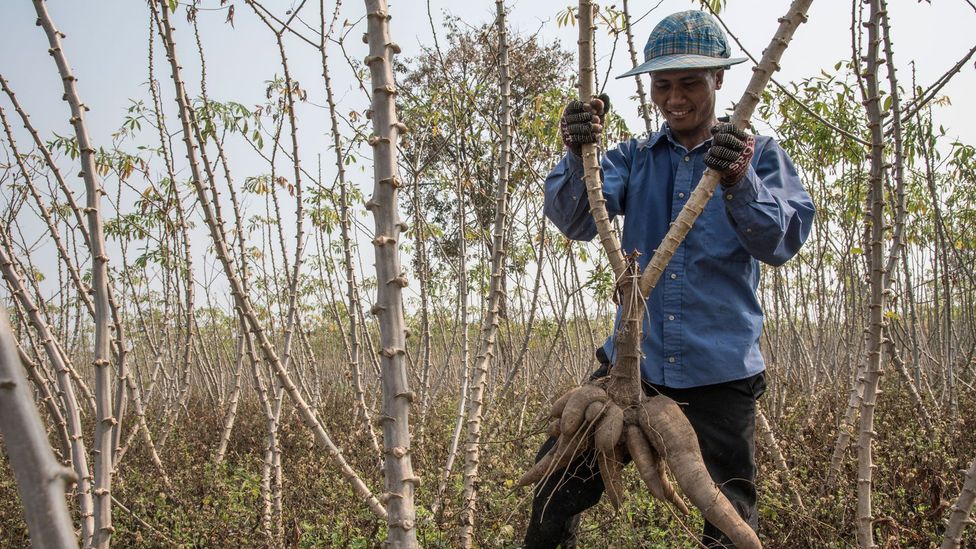
The cassava crop is incredibly important to the economies of South East Asia (Credit: Getty Images)
When the same wasp was used to control mealybugs in West Africa in the early 1980s, it promptly suppressed the pest population levels from more than 100 individuals on each cassava tip to fewer than 10-20. Less than three years later, the wasp had effectively dispersed over 200,000 sq km (77,220 sq miles) in southwestern Nigeria and could be found on the vast majority of cassava fields in the area.
This type of intervention is called classical biological control. You find a natural predator and introduce it to a crop to curb the spread of a pest. Wyckhuys calculated the economic benefit to the farmers across 26 countries in Asia-Pacific at $14.6bn to $19.5bn (£11.4bn to £15.2bn) per year. “The action of a 1mm wasp helped to resolve a major financial shock in the global starch market,” he says.
Our understanding of the benefits of the right predator in cropland stretches back millennia, though biocontrol has largely fallen out of fashion in modern farming practices. “Biological control was the default for thousands of years, so it’s funny to think of it as new,” says Rose Buitenhuis, a scientist at the independent horticulture science organisation, Vineland Research and Innovation Centre, in Ontario, Canada.
If biocontrol can be so successful, why is it now an uncommon method of fighting pests? What happens when it goes wrong? And why are researchers pushing to change that?
You might also like:
- Planting trees doesn’t always help with climate change
- The ‘pandemic’ destroying the world’s favourite fruit
- The farms growing beneath our cities
To the people of pre-Columbian Mesoamerica, cane toads existed somewhere between life and death, and were revered as a mediator to the underworld. The amphibians produce a powerful toxin capable of inducing hallucinogenic experiences that priests used in rituals to communicate with their deceased ancestors. The Maya people are famous for worshipping snakes and birds of prey, which feature in exquisite examples of Mesoamerican art. But the Maya, and other indigenous peoples, also portrayed the humble toad in artworks, often grinning cheerily as if enjoying the effects of their own psychedelic toxin.
The Maya carved toads and frogs into pots and vessels. As semi-aquatic animals and harbingers of rain – essential to the health of crops – they are synonymous with water and therefore life. Their metamorphosis from eggs to tadpoles to toadlets indicated the beginning of the rainy season, emerging from the water as if they were emerging from the underworld.
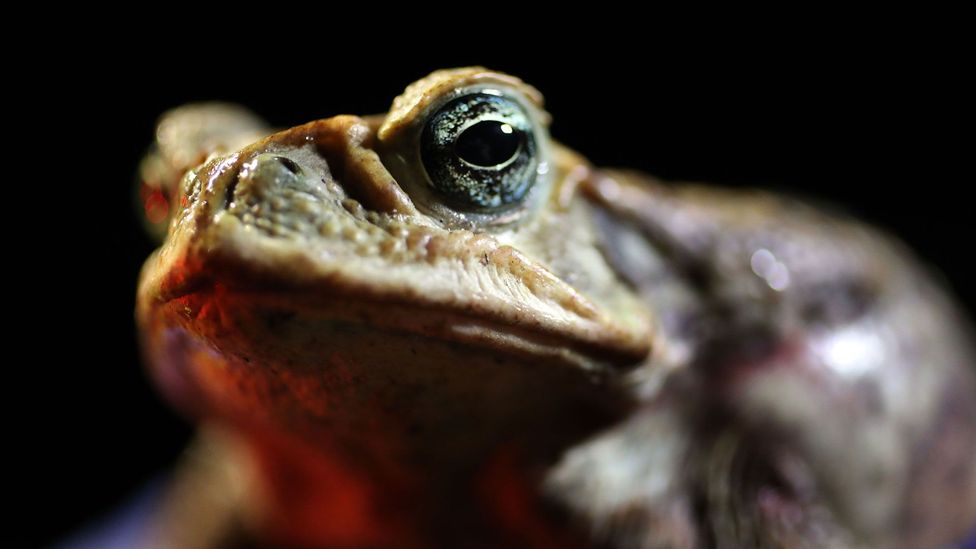
The ancient Maya understood the duality of the cane toad: it is both deadly and a sign of better times to come (Credit: Getty Images)
The toad was also seen a powerful ally in keeping crop-destroying pests at bay. They were welcomed in cornfields and storage bins, where they are a naturally-occurring predator of beetles and small rodents that might decimate a crop. But the same neurotoxin, bufotenin, that the priests used as a hallucinogen was also the cane toad’s primary defence against its own predators and it is poisonous enough to kill a human if they are careless.
The indigenous peoples of Mesoamerica understood the duality of the natural world. The cane toad represented both life and death. Painted on one Maya vessel is a cane toad presenting a platter with a human eye, bone and hand to a jaguar and serpent who dance joyously in the underworld. The Maya respected the toad’s potency and welcomed its presence. They also knew that messing with nature could have grave consequences.
The cane toad is hated in Australia. Imported from the Americas as a biocontrol in 1935, it thrived in its new environment on the sugarcane crops of the northeastern states. The abundance of its favourite prey, the cane beetle, along with other native Australian insects, and the absence of suitable predators meant that cane toad numbers exploded. In 2007, the cane toad was estimated to cover about 1.2 million sq km of Australian wilderness and number 1.5 billion individuals. Its range is likely to increase with climate change.
The result was devastating. Predator populations crashed – species that would normally prey on native toads, like quolls, a type of marsupial, and goannas, types of large monitor lizard, died from the cane toad’s toxin. The Australian government and local campaigners destroy millions of toads each year. The cane toad’s reputation is so poor in the country that the amphibian’s plight has been the subject of ironic children’s books.
“The toads were released contrary to scientific advice at the time,” says Wyckhuys. Releasing the toads “was something that should never have been done and is entirely impossible in modern biocontrol – you don’t release generalist, polyphagous, vertebrate predators. It is not a tiny red flag, it is a massive red banner”.
The cane toad is not alone. There are at least ten instances of biocontrols becoming invasive species throughout history. In World War Two, Japanese and Allied forces released mosquitofish to prey on mosquito larvae in an effort to reduce the spread of malaria among troops on Pacific islands. These small, innocuous-looking fish are now an invasive species in that area, where they dispersed quickly and outcompeted local species. The same applies to the Asian ladybug in Europe, introduced to control aphids.
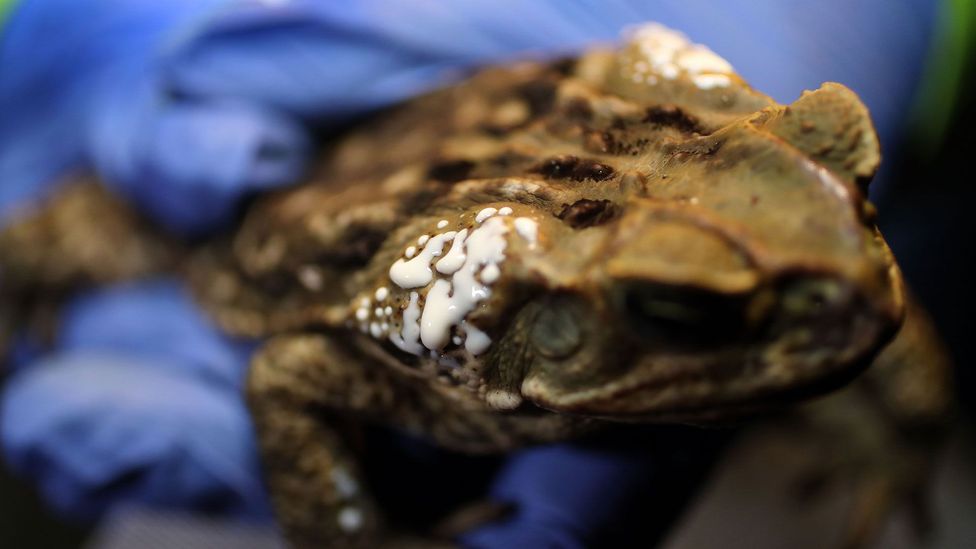
A cane toad secretes its dangerous bufotoxin from glands behind its head (Credit: Getty Images)
As a result of high-profile failures like this, the use of chemical controls – pesticides – instead of biocontrols gathered momentum in the first half of the 20th Century. But, with a handful of exceptions, the controversial image of biocontrols is largely unfounded. Successful introductions of biocontrols outnumber the failures at least twenty-five-fold.
Now, some researchers are trying to change biological controls’ perception. They say the days of pesticides are numbered.
The end of pesticides?
“Chemical controls solved a lot of problems in the 1930s, 1940s and 1950s,” says Buitenhuis. “Farmers didn’t have to work as hard. They could just go to their cabinet, find a spray and the pests would die.”
The issue with chemical controls is that pest species breed quickly, which means that an individual who is resistant to a pesticide can very quickly produce resistant offspring. Pesticide producers then have to constantly refine their products just to keep up with the pest – what Buitenhuis refers to as a pesticide resistance treadmill and is elsewhere called the “red queen effect”, after the Red Queen from Through the Looking Glass.
The number of pesticides available to farmers is running out. In 2018, three pesticides from a class of chemicals called neonicotinoids were banned outright by the EU having already had their use severely restricted in 2013. These chemicals, which are similar in structure to nicotine, coat seeds to protect them from pests in the soil. However, as the crop grows, the pesticide is absorbed and spreads throughout the plant’s tissue where it collects in the pollen and nectar. Both wild and domesticated pollinators feeding on those plants are then exposed to the pesticide.
Critics of the ban point out that limiting seed-treatment pesticides could end with them being replaced by spray-on pesticides, which can be equally damaging to pollinators and are more expensive to farmers.
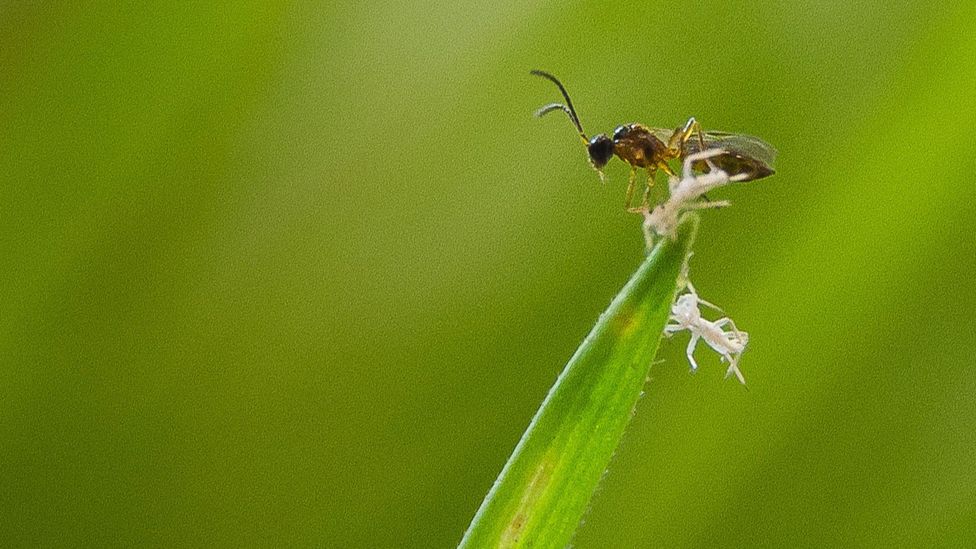
If pesticide use is to decrease, might more farmers turn to biological controls like this parasitic wasp? (Credit: Getty Images)
“There is a whole range of negative social and ecological factors tied to pesticides,” says Wyckhuys. “From the greenhouse gases used to produce and distribute chemicals – substantial greenhouse gas emissions – to human health implications for farmers and consumers. The impacts are not just restricted to the fields or to the farm but they are amplified across the landscape [by leaching], propagated through surface water or dust, taken up in the air by aerosols.”
Pesticide residues have been found in the cloud forest of Costa Rica and the Great Barrier Reef in Australia. And when pesticides appear in the wrong place, they become biocides – something that kills life. When they leach into the environment around farm land, they simplify biological communities and degrade ecosystems. What appeals to scientists like Wyckhuys about biocontrols is that their application can be much more targeted.
Caroline Reid, senior technical lead from Bioline Agrosciences, a biological control producer in the UK , agrees. Add to the specificity of biocontrols a reduction in the number of chemicals that are safe to use and a push across the EU towards sustainable farming and you can see why biocontrols are becoming increasingly mainstream. But how do they work?
Biological controls
There are broadly three types of biocontrols: predators, parasitoids and pathogens. Cane toads are an example of a predatory biocontrol. They prey on cane beetles, but unfortunately they are not overly choosy (they are “polyphagous”) and in Australia they began preying on other native insects which were not pests.
Parasitoids are a little more gruesome. Often these types of biocontrol are species of parasitic wasp or fly who lay their eggs inside caterpillars or beetles only for the resulting larvae to break out of their host’s abdomens, killing it in the process.
Pathogens can take the form of fungi, viruses or bacteria that kill or make their host infertile. These tend to target quite specific species of pest, making them a popular choice for modern biocontrol research because there is a lower risk of them attacking other harmless species with unintended consequences. Though, as we have all found out recently, viruses do from time to time jump species quite successfully.
Successful biocontrols should have a high reproduction rate, so they can multiply quickly when they detect a pest, be very specific in which species they target and able to seek their prey efficiently. In practice no biocontrol is perfect. Instead, researchers finely balance the risks associated with each of these.
There are also three ways that biological controls can be applied to a crop: classical, conservation and an augmented approach.
The cane toad is an example (if rather a bad one) of classical biocontrol – in which a new species is introduced into the environment.
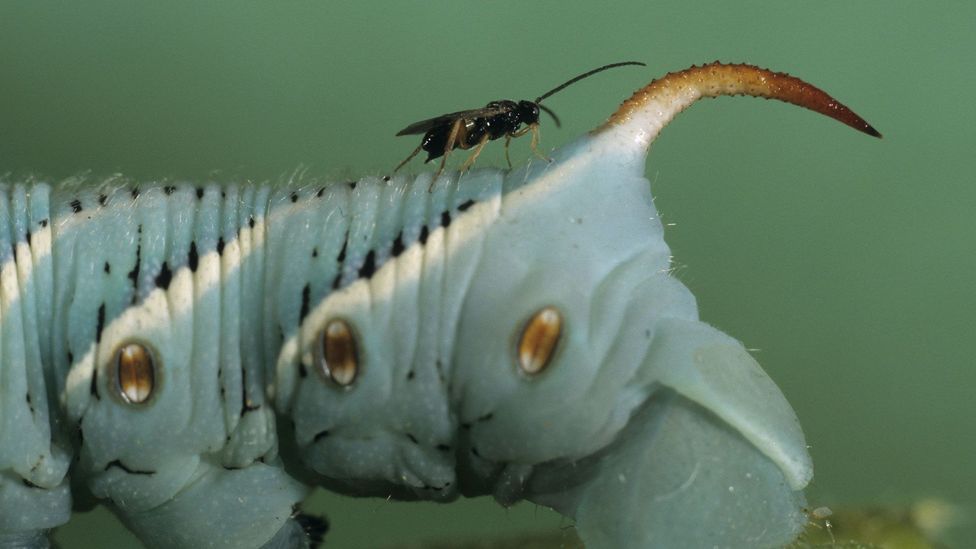
A parasitic wasp (Cotesia congregata) climbs onto the back of a tobacco hornworm caterpillar where it will lay eggs in the host, eventually nullifying it (Credit: Getty Images)
“The classical form of biocontrol is specifically geared to invasive species management,” says Wyckhuys.
Biocontrol offers the option to go back to the region of origin of that pest, study the co-evolved natural enemies and choose the organisms that are highly effective at controlling them. “We don’t want to introduce an organism that is going to attack other organisms. We select an effective biocontrol that is highly specific,” says Wyckhuys.
Alternatively, in conservation approaches, predators that already exist within the environment are promoted by protecting their habitat. This can be done by increasing the amount of hedgerow or meadow around a field.
In a study on cabbage farming, where there was a high proportion of meadows surrounding a cabbage plot, numbers of cabbage-eating caterpillars were lower. This was likely due to the greater presence of parasitic wasps in those environments, the researchers say. However, in other instances, meadows promoted the presence of pest species like aphids and flea beetles. It’s not as simple as introducing more meadow to cut down on pests – the dynamics between farmland and wild land need to be carefully managed.
Conservation biocontrols like this are also limited to controlling pests which are native to their local environment. Like classical biocontrols, many pest species were first introduced to their environment by humans – they weren’t necessarily already there. As countries import seeds and crops from across the world, it is easy to assume that the odd accidental pest tagged along. Now, finding themselves in a new environment without a natural predator, they flourish.
Finally, in augmented approaches a pathogen or parasite is introduced to a crop at a key time – perhaps when pests begin to breed or lay eggs, or even before the pest arrives – so that the control species quickly nullifies their threat before their own numbers dwindle and they too die out in that area. The advantage of this approach is that you can be very specific with how you tackle the pest species.
“Augmented control is very popular in the European greenhouse sector,” says Wyckhuys. “In some areas pesticide use is zero.”
Greenhouses have been the domain of biocontrols for decades, even while chemical pesticides had their boom years. They have a big advantage of being a more or less closed system, so a predatory biocontrol is not going to fly away. Then there is the fact that greenhouse crops tend to be higher value – tomatoes, peppers and cucumbers sell for more per unit area than cereals, for instance.
In more recent years the popularity for biocontrols has spread to other sectors such as floraculture, viticulture and outdoor fruits like strawberries.
“In Canada we did a survey in 2017/ 2018, 92% of flower growers use biocontrol as the main pest control strategy,” says Buitenhuis. “It is an amazing success story and came about because of pesticide resistance, especially in Canada.”
Buitenhuis and Reid know that when large surface area crop farmers switch to biocontrols for their cereals and grains, the momentum will have swung back in their favour. “If an arable farmer decided that a biocontrol is usable on wheat or barley that is us cracked it,” says Reid. Likewise, Buitenhuis says that persuading countries like Colombia, Ecuador and Kenya to adopt such approaches would be “big wins”.
“It is coming,” says Buitenhuis. “Using chemicals only is not a long-term sustainable strategy.”
--
Join one million Future fans by liking us on Facebook, or follow us on Twitter or Instagram.
If you liked this story, sign up for the weekly bbc.com features newsletter, called “The Essential List”. A handpicked selection of stories from BBC Future, Culture, Worklife, and Travel, delivered to your inbox every Friday.
"industry" - Google News
November 25, 2020 at 08:08AM
https://ift.tt/3nWJMY2
The tiny parasitic wasp that saved an industry - BBC News
"industry" - Google News
https://ift.tt/2RrQtUH
https://ift.tt/2zJ3SAW
Bagikan Berita Ini














0 Response to "The tiny parasitic wasp that saved an industry - BBC News"
Post a Comment